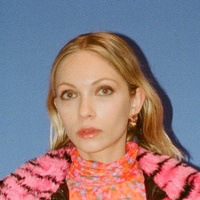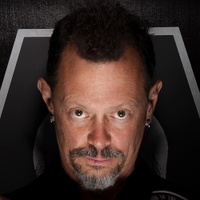On why you're more than what you make
Prelude
Sharon Louden is an artist, educator, advocate for artists, editor of the book series Living and Sustaining a Creative Life, and the Artistic Director of the Chautauqua Visual Arts.
Conversation
On why you're more than what you make
Artist and educator Sharon Louden discusses the changing definition of being an artist, her day-to-day as a residency’s Artistic Director, and why porches are a perfect place for community conversations.
As told to Daniel Sharp, 2442 words.
Tags: Art, Culture, Collaboration, Education, Mentorship, Inspiration.
How did you first come into contact and conversation with Chautauqua Visual Arts?
My first teaching job here ever was in 1992 at Chautauqua Institution. I taught teenagers and pre-college students how to draw and paint. I was here for the summer, and the director then was Don Kimes, who gave me this opportunity. He was the predecessor whom I replaced here as artistic director.
How did the artistic director role actually start?
The School has been around since 1909. The Institution’s been around since 1874, and the School of Art has always had an artistic director. So over the years, they’ve had different people come in and direct this program, where their individual visions form what the school is about.
It sounds almost like a legacy, or ongoing conversation, where artists are placed at or near the top of decision making power.
Well, yes. There have been different artistic directors who wear multiple hats, but I do think The Chautauqua Institution is very aware that in order to direct a program such as this, their artistic directors have to be intimately connected to the field they’re involved in.
Why do you think they need to be so intimately connected?
Because Chautauqua Institution is based on lifelong learning and bringing people in who can extend culture once they leave. For example, the residency is eight weeks, and each week, a visiting lecturer comes to Chautauqua who shares their knowledge to around 40 artists from all different places, ages, and cultures. The artists will carry that with them when they leave us and move back out into the world.
That’s why I believe that we have to live in the here and now. While we carry history with us, and while we have to acknowledge the past in order to move forward, Chautauqua Visual Arts can be a brave space to incubate that culture.
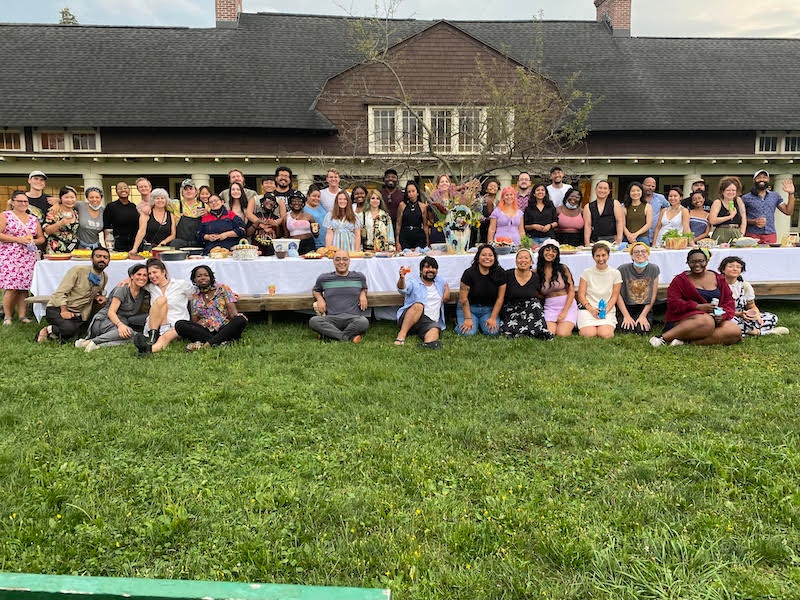
Chautauqua Visual Arts Dinner
What does it mean to you to be an artistic director of a residency?
Well, I wear multiple hats, but I think the hat that I wear the most is as an artist. What that means today is variable, but for me, an artist is far more than just a maker. We do a lot more before we even start to make something. It’s the way we think, the way we talk, we observe, we direct. That’s why I took this position: to create and hold space for others, especially people’s voices who haven’t been amplified in order to address and attempt to correct historic exclusion. Chautauqua seemed to be the right place at the right time to do this, as the Institution and School have been embedded in progressive history for over a hundred years.
I’m curious if you consider being an artistic director of a residency part of your practice as an artist.
Absolutely. I think everything that I do is intertwined. There’s a tremendous amount of creativity in administrative work. Especially for me as a white person, I want to share my privilege by making and holding space for others. I want to create a brave space, not just a safe space. I try to do that in anything I do: in my sculpture, in the books I edit, with the hope of creating opportunities and relationships for others. Being an artist in any position, I think, yields creativity, innovation, humanity, empathy, and consideration of others.
It makes me think about recent conversations with a friend of mine who only produces one, maybe two paintings a year. Because of that small volume, and because her day job is outside the arts, she has a hard time calling herself an artist. But my argument back to her was, no, you are an artist, because it isn’t just isn’t about the number of paintings you make, it’s about how you live. It sounds like you’ve arrived in a similar space.
Definitely. Being an artist is more about how we think, how we live, and what we say. When I worked for Alyson Pou at Creative Capital, she always would tell me that when an artist comes into a conversation or walks in the room, they often have a lot more to say without even saying it. Artists have so much to give because they carry the knowledge and experiences from others with them. We start things from nothing. We have a lot of bravery. We don’t need preparation, we just do it. And we bounce back from failure.
Do you think if an artist failed at making something, they would stop being who they are? No! They keep going. Most artists do their work because it is just who they are and part of their truth.
I’m curious about your day-to-day work, especially during the off season.
Part of my job, and from my values, is to be able to present this program to as many people who aren’t from places we historically think as central to where artists live, like New York or Los Angeles or other big cities. I reach out to academic institutions, nonprofit organizations, and individuals in different nooks and crannies, say hello, and share what we have to offer, like our information sessions.
I develop relationships with people and communicate constantly with our faculty and all 64 of our partners. And I work to ensure they continue beyond my years here, because I believe a relationship should never end—unless something terrible happens to us. A relationship is a seed to grow and collaborate.
We then go through a tremendously intense admissions process, where myself and the lead faculty decide who gets into this program. Everyone who isn’t accepted receives feedback directly from me. To this day, I’m still giving feedback to hundreds of artists, because we had the highest number of applications this year, and every year it increases.
The program that I run here is certainly not just about me. I am the Director, but the lead faculty at the Chautauqua School of Art play a large role. It’s a team-led situation. I oversee the difficulties and the structure and I sometimes feel I’m driving bumper cars. But that makes me happy. I’ve always loved bumper cars since I was a child.
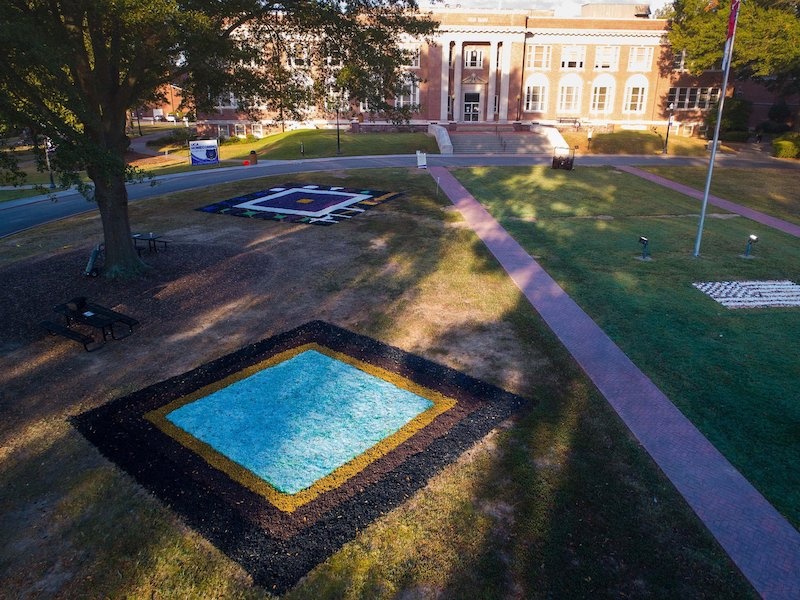
Suffrage Rugs, 2020, courtesy Seth Foley and Melissa Cowper-Smith
I can then imagine that the work during the residency requires a lot of day-of logistics, like helping guest lecturers find the site and making sure the artists know where to go. But it also sounds like it requires ensuring they come together to inspire each other and grow so they can take their new knowledge through to the rest of their life.
Running a residency is really about the maximum of the minutiae and everything in between. The key to this program is how hybrid it is. The School of Art is an intergenerational residency program with people from all different walks of life and ages and cultures which results in a lot of dynamism.
The Chautauqua Institute was always about sharing resources and having a place for discourse. There are a lot of metaphorical fireworks. It’s wonderful. But sometimes it’s not wonderful. The ups and downs require being in touch with different humans at different times, and that takes vast amounts of energy, time, and attention. But not only are we willing to spend that time and attention with the residents, we love doing so.
Does the geographic location of Chautauqua have an impact on your work? I’m thinking not only along the lines of the town being the homelands of the Erie and Haudenosaunee, but also the importance of the town in early rail lines and the town developing the pop-up education and entertainment centers called Chautauquas. Do these histories flow into your present work?
I love that I work in a place that has different dynamics and elasticity. We are located on the Seneca-Iroquois Nation’s land. Chautauqua is also in the second poorest county in New York State. We’re about two hours away from Cleveland, two hours from Pittsburgh, an hour and 40 minutes from Buffalo, and under four hours from Toronto.
We invite everyone to visit from different geographic, economic, and racial contexts come. It yields so much growth. I think about what making space really means for another person. How do we walk into each other’s spaces? What do we need to be able to be there?
Artists have a tendency to buy into the art world system which, over the years, has yielded pretty exclusionary spaces. White walls make a lot of people feel unwelcome. Our residency tries to embrace the opposite. We’re situated in a place with all this richness of conflict and exchange. It’s an opportunity to think beyond one art world.
I’m curious if your work ever engages with Chautauqua’s city workers, like elected officials.
The Chautauqua Institution definitely does. When I first became Artistic Director in 2018, I first reached out to the Director of the Seneca-Iroquois National Museum, Joe Stahlman. I work with him a lot. He’s on my board of the Friends of CVA. We also reach out to a lot of local communities. Chautauqua Visual Arts develops relationships with a lot of local organizations.
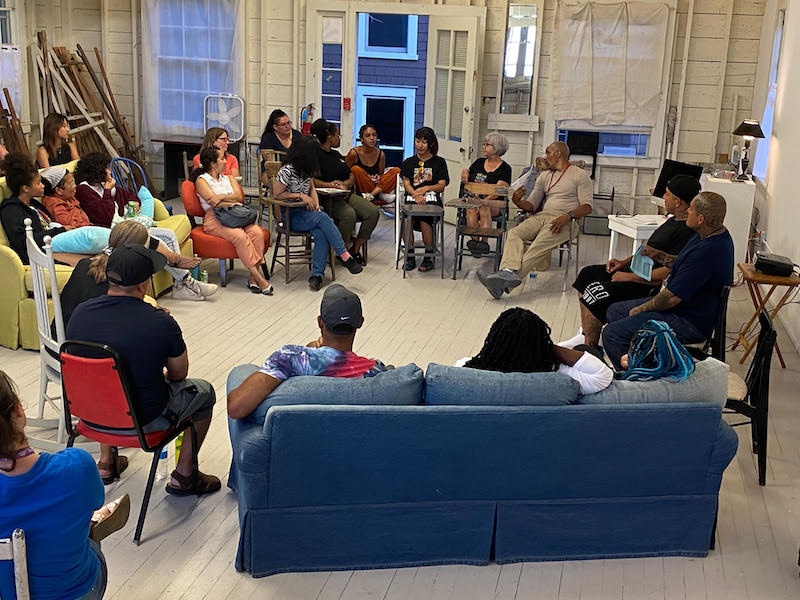
Chautauqua Visual Arts
Why do you think these neighbors, the Chautauquans and the local organizations, buy into the work you do and join you every year?
Chautauquans have been coming here generation after generation. Many of them have houses in town that have been passed on from family to family, and they return out of tradition. There’s just so many spectacular people who come here, share knowledge, and promote conversation. Our program becomes an incubator. It’s a space of constant conversation.
There are also lots of porches in Chautauqua. So, let’s say, after someone comes and gives a talk, everyone goes to their porches and talks about it for days. The community here and the community that comes in have an intellectual appetite. They want to eat it and they want to drink it and they want to soak it in and they want to be present within that energy. That’s why so many come back.
Why should artists be in decision making capacities or advisory boards for residencies?
Why wouldn’t they be? Artists have been underrated for so many years. There’s been this exclusive perception of artists, where we’re lazy, or we don’t pay our rent. That’s totally wrong. I think we look at the world in different ways, and we’re risk takers. So if you think about what we do in our studios, or how we make or talk about or observe or read things or bounce into ideas without even preparation, because we have that trust in our own community, it shows that we can lead with empathy and compassion. And that’s what I attempt to do as an artistic director.
Why do we have artist residencies in the first place?
Artist residencies give respite and opportunities for community building when it’s nearly impossible to do so in other locations. So for example, if you move to New York City for the summer, a city of more than 8 million people, you might feel like you’re a part of a community. But there’s a whole lot of other people there. It’s hard to actually meet your community in a short period of time.
But if you were accepted to the Chautauqua School of Art residency program, myself and the faculty members have already decided on who else is coming. There are a lot of threads between each of us already. At Chautauqua Visual Arts, they don’t have to “make anything.” They can think, they can just be. So each year we’ve done this, the cohorts stay together and lean on one another for years. They share their work and grow with one another. They create opportunities for one another. And that’s what we hope for every summer. I think most residency programs provide experiences like that, let alone the opportunity to work and grow however the artist wishes.
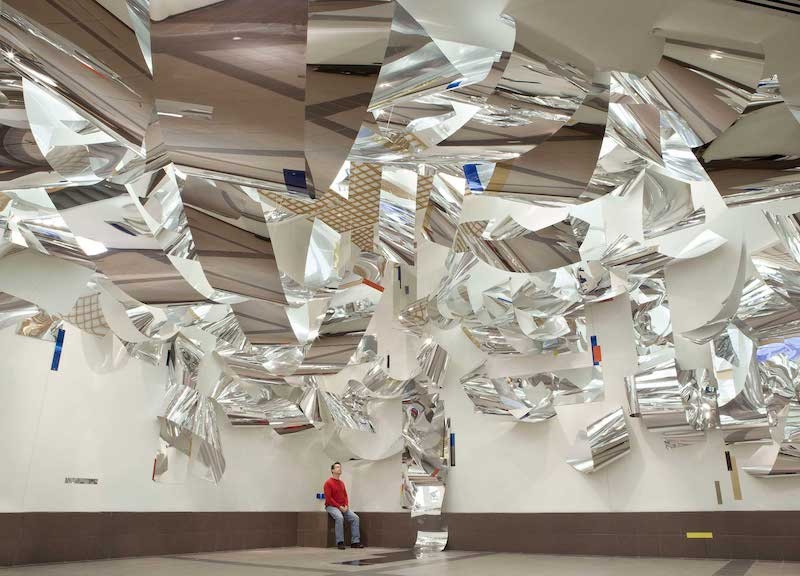
Windows, 2015 to 2017, courtesy Christopher Gallo
Could someone else in a small town do something similar to Chautauqua Visual Arts? Do they need a legacy of local people wanting to invest time and energy into the program, or is there a way to fast track some of the work?
It happens all the time. For example, there’s a town outside of Duluth in Minnesota, where Annie Dugan started a residency. She realized her small rural community didn’t have a place for local artists to come together. She has a farm and loves artists, so she started one for them. There’s another artist, Susan Delgalvis of Grand Junction, CO, who also created a space where she wanted to get her community together. She started with a dinner, and that dinner became Open Studio Fridays and Gallery Fridays once a month in Grand Junction. It’s all about communities of artists coming together—it works.
Starting a residency is all about defining the space, the place, and the needs of the community. If you can generate the energy to sustain it, like any art project, I definitely think it can happen again. Why not?
There’s something I find interesting about your work as an artist where you’re building platforms and then stepping aside, up, or down from the spotlight. Why should artists be passing their platforms and the mic to others?
Well, first they have to hold the mic. Artists have to be strong enough to hold the mic. They have to acknowledge they’re holding the mic so that they don’t disappear from the community. But it’s not just artists that do this. Passing the mic around is something I think works across humanity. It’s a part of being human. I don’t see it as an artist’s responsibility. I don’t even see it as a responsibility. I just see it as a natural form. It’s like a conversation.
Sharon Louden Recommends:
Hakim Bishara’s writing and curatorial practice:
The remarkable work of Jose Arellano and everyone at Homeboy Industries
Miguel Luciano’s recent residency at the Met
bell hooks’ Teaching to Transgress
- Name
- Sharon Louden
- Vocation
- artist, educator, advocate for the artists, editor, artistic director
Some Things
Pagination
